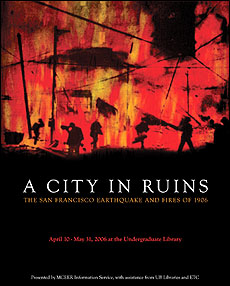Archives
MCEER commemorates 1906 disaster
Exhibit chronicles earthquake, fires that devastated San Francisco
By ELLEN GOLDBAUM
Contributing editor
The Multidisciplinary Center for Earthquake Engineering Research (MCEER) Information Service is commemorating the 100th anniversary of the devastating 1906 earthquake with a major exhibit, "A City in Ruins: The San Francisco Earthquake and Fires of 1906."

POSTER DESIGN: DAVID PIERRO OF MCEER
The exhibit, which is free and open to the public, is located on the first floor of the Undergraduate Library on the North Campus until May 31, when it will move to Lockwood Library, where it will remain through the summer.
The earthquake on April 18, 1906, and the ensuing fires killed at least 3,000 people, left more than 200,000 people homeless and destroyed half of San Francisco, which was then the largest city in California and the financial and cultural heart of the western U.S.
Writing the day after he experienced the earthquake, author Jack London stated simply: "Not in history has a modern imperial city been so completely destroyed. San Francisco is gone."
That quote and others from famous witnesses to the tragedy, including opera star Enrique Caruso, actor John Barrymore and photographer Ansel Adams, are featured in the exhibit.
The exhibit also consists of seven display cases containing numerous dramatic images from UB's and MCEER's collections. The images show the devastation the quake and subsequent fires caused to buildings and neighborhoods, the tent cities that sprang up, the food lines, and the faces of children and families left homeless by the quake.
One display case focuses on Chinatown, the devastation that the community experienced and efforts by the city's officials to repossess it following the quake because it was located in one of the city's most desirable areas.
The social and humanitarian crises that resulted also are depicted through images and descriptions.
The exhibit provides a perspective on how architectural landmarks fared, including the San Francisco City Hall, which recently had undergone a $7 million, 10-year renovation; it was utterly destroyed.
In addition, information on how the quake changed forever how communities prepare for, and respond to earthquakes is featured, including the response at the time by insurance providers.
The exhibit highlights UB's close connections to earthquake engineering and mitigation, as the home of the Multidisciplinary Center for Earthquake Engineering Research, the MCEER Information Service, and one of the nation's most sophisticated earthquake engineering laboratories.
"This exhibit provides us with an opportunity to showcase the efforts of both MCEER and its Information Service in conducting research and providing an avenue for education and outreach in mitigating disasters of all types," said exhibit curator Sofia A. Tangalos, an MCEER senior program officer.
She noted that MCEER has been involved actively in multihazard reconnaissance efforts following Hurricane Katrina, the Asian tsunami and the Sept. 11, 2001, attacks on the World Trade Center.
The exhibit was developed by Tangalos and Jill Tarabula, MCEER Information Specialist and David Pierro, MCEER graphic designer. Nancy Schiller, associate librarian, Science and Engineering Library, Peggy Pajak of the Preservation Department of the UB Libraries and staff at the Educational Technology Center also made important contributions to the exhibit.
UB's Multidisciplinary Center for Earthquake Engineering Research Information Service is a comprehensive source for information on earthquake engineering, earthquake hazards mitigation, disaster preparedness, and related topics.
Founded in 1986, the Multidisciplinary Center for Earthquake Engineering Research headquartered at UB is a national center of excellence in advanced technology applications dedicated to reducing losses from earthquake and other hazards nationwide. One of three such centers in the nation established by the National Science Foundation, MCEER has been funded principally over the past 20 years with $68 million from the NSF, $36 million from the State of New York and $26 million from the Federal Highway Administration. Additional support comes from the Federal Emergency Management Agency, other state governments, academic institutions, foreign governments and private industry.
